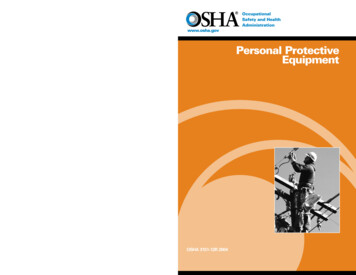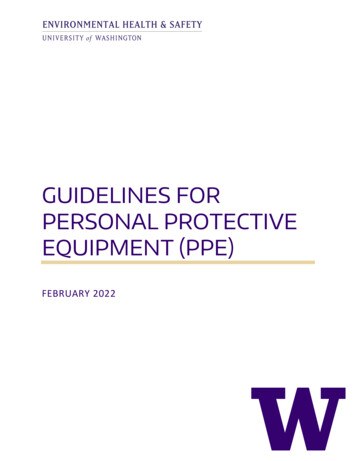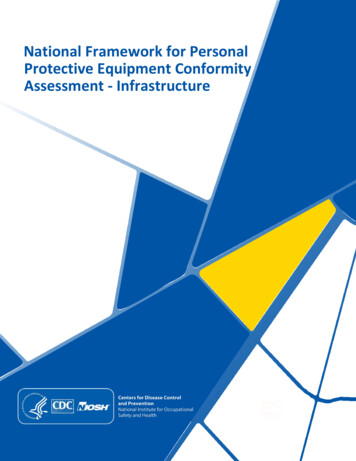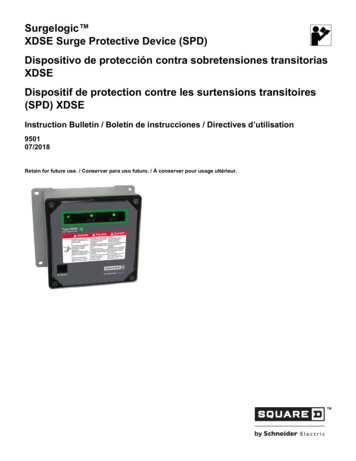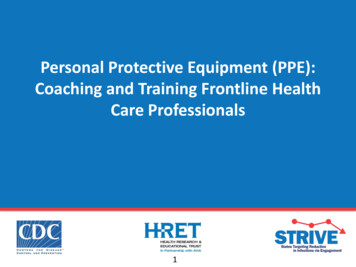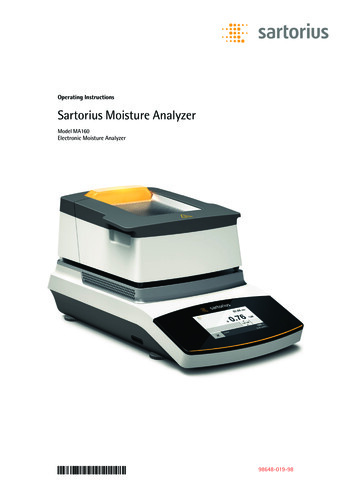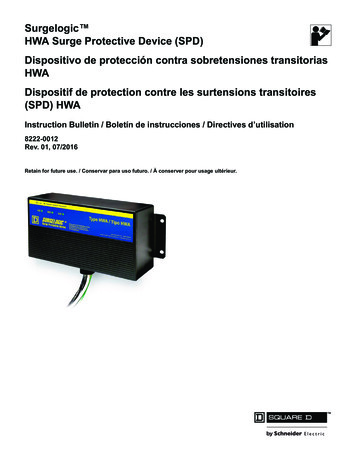
Transcription
Personal ProtectiveEquipment Manual (PPE)1
Environmental Health and SafetyFacilities Management and DevelopmentTable of contents1. Introduction42. Legislation43. Responsibility43.1 Employer Responsibilities43.2 Supervisor Responsibilities43.3 Worker Responsibilities44. Signage55. Training56. PPE and hazard control57. Selection of PPE67.1 Guidelines for selection:6A) Match PPE to Hazard6B) Involve Workers/Users6C) Check the Fit6D) Training6E) Maintenance7F) Review78. Body Protection (Protective Clothing)8.1 High-visibility safety apparel (HVSA):778.1.1 Classes88.1.2 Selection 0Colour:102
Environmental Health and SafetyFacilities Management and DevelopmentCare/Maintenance:8.2 Lab Coats:9. Hand Protection1010139.1 Glove Selection Guidelines149.2 Chemical Glove Selection Guidelines169.3 Use and Care of Gloves179.4 Glove removal189.5 Latex Allergies1910. Foot Protection10.1 Footwear Selection192011. Eye and Face Protection2312. Head Protection2312.1 Classification2412.3 Components2512.4 Use and Maintenance2513. Hearing Protection13.1 Wearing Soft Foam Ear plugs14. Respiratory Protection14.1 Types of Respirators2627292914.1.1 Air-purifying respirators2914.1.2 Supplied-air respirators3114.2 Selection, use and care of respirators3114.3 Fit-testing3214.4 Proper Fit3214.4.1 Negative-pressure seal check3214.4.2 Positive-pressure seal check3315. PPE Availability33Appendix 1353
Environmental Health and SafetyFacilities Management and Development1. IntroductionPersonal protective equipment is a general term referring to any equipment that is worn by aworker to protect against hazards and injuries. Some examples are respirators, gloves, earplugs, hard hats, safety goggles, and safety shoes or boots.2. LegislationSection 25(1) under the Occupational Health and Safety Act (OHSA) requires employers to provide equipment, materials, and protective devices make sure they are used as prescribed maintain them in good conditionThe OHSA also requires workers to use or wear the equipment, protective devices or clothingthat has been prescribed by regulations, e.g., Regulation 851 (Industrial Establishments,sections 79-86) . Hence, all faculty, staff, students, visitors, and volunteers performing tasks orentering areas that require specific Personal Protective Equipment (PPE) should wear theappropriate PPE.3. Responsibility3.1 Employer ResponsibilitiesEmployers have a legal responsibility to ensure that: The appropriate Personal Protective Equipment as prescribed in the regulations isprovided;PPE provided is maintained in good condition;PPE provided is used as prescribed;Workers are provided information, instruction and supervision on the use and care ofrequired PPE;they comply with the regulations or standards limiting the exposure of a worker tobiological, chemical, or physical agents as prescribed in the regulation; andEvery reasonable precaution is taken to protect the health and safety of the worker.3.2 Supervisor ResponsibilitiesSupervisors have a legal responsibility to ensure that: Workers use and wear properly, the appropriate PPE (including protective clothing) thatthe employer requires to be used or worn;Workers are trained in the use and care of required PPE before they wear or use theprotective equipment;Records of this training are maintained and kept in an accessible location;Workers are informed of the existence of any potential or actual danger to the health andsafety of which the supervisor is aware;Every reasonable precaution is taken to protect the health and safety of the worker.3.3 Worker ResponsibilitiesWorkers have a legal responsibility to ensure that:4
Environmental Health and SafetyFacilities Management and Development They use or wear properly the PPE that the employer requires to be used or worn;They inspect PPE regularly before each use;Absences or defects in any PPE of which the worker is aware and may endangerthemselves or another worker is reported to their supervisor or employer immediately;They do not use PPE in a manner that may endanger themselves or others.4. SignageWorkspaces with specific PPE requirements must have signage posted upon entry of the areaand/or near the source of hazards outlining the PPE required. PPE signs remind users to wearprotective gear in the workplace. EHS can be consulted to help choose the right signage foryour area. Please see Appendix 1 for examples of hazard specific signs.5. TrainingPrior to conducting work or being in a PPE prescribed area requiring the use of PPE,workers/students shall be trained in the following: When PPE is necessary What type is necessary How it is to be worn What its limitations are Proper care, maintenance, life expectancy and disposalSupervisor must provide training to ensure the worker/student is able to demonstrate, uponcompletion of the training, the above-mentioned information. Any type of training format can beused as long as a hands-on session is incorporated. The Supervisor must have documentationof this training and proof that the training information was understood. Ryerson also offers aPPE awareness eLearning training. Please visit -protective-equipment/ fordetails of the training.To reduce the risk of entanglement: 6.Keep long hair tied back or tucked under a hatKeep zippers and buttons done upMake sure clothing fits close to the bodyEliminate drawstrings and other dangling pieces from clothingRemove hanging threads and fix tears in clothing to prevent entanglementRemove jewelleryPPE and hazard controlThe standard approach to dealing with potential hazards must include a risk assessment todetermine the requirement for PPE use. There are five basic ways to control hazards, whereelimination is always the first control to consider. After that, proceed down the hierarchy until thecontrol of last resort being PPE.1.2.3.4.Elimination (remove the hazard from the work site)Substitution (use a less harmful chemical)Engineering (isolate equipment/set guards)Administration (provide training/maintenance)5
Environmental Health and SafetyFacilities Management and Development5. Personal Protective Equipment (provide gloves/goggles)The use of PPE does not prevent accidents or eliminate hazards. Make every effort to control allhazards at the source. Training is also important. PPE cannot achieve its full-protection potentialwithout worker knowledge and cooperation.Several controls may have to be put in place. Certain hazards may require multiple PPEsolutions. Wearing PPE should not add to the hazard or create a new hazard. For instance,proper glove selection can prevent skin damage, but gloves worn while working with movingequipment can create an entanglement hazard. Using different types of protection at the sametime i.e. hard hat, earmuffs and goggles, should not increase the risk to the worker.PPE design criteria cannot cover all eventualities. Do not use PPE when its usage createshazards greater than those for which it is designed. Take uncertainties into account whenevaluating potential hazards.7.Selection of PPEOnce the need for PPE has been established, the next task is to select the proper type. Twocriteria need to be determined: 7.1Degree of ProtectionAppropriate DesignGuidelines for selection:A) Match PPE to HazardChoose the right PPE to match the hazard. In some jobs, workers continually perform the sametask. In other jobs workers may be face different hazards. For instance, a welder requiresprotection against welding gases (respirator), harmful light rays (welder’s goggles), and moltenmetal and flying chips (gloves, welding hood, welding helmet).B) Involve Workers/UsersTo ensure that the fit, comfort, and acceptability of the PPE, involve workers/users in valuationsof PPE. Allow for personal preferences and flexibility with choice of PPE, as long as it meets therequired legislation and standards.C) Check the FitIt is important to fit each user with PPE individually. Certain fitting programs require qualifiedpersonnel. Some types of equipment, like respirators, require annual fit testing to ensure they fitthe face of the individual worker. Show workers how to wear and maintain PPE at the time offitting.D) TrainingWorkers and their supervisors need training in when, where, why, and how to use theequipment to achieve the necessary level of protection. All workers need training, whetherexposed on a regular or occasional basis, for example, in emergencies or with temporary workin dangerous areas.6
Environmental Health and SafetyFacilities Management and DevelopmentTraining includes: How to fit and wear PPE.Why the PPE is necessary.How to adjust it for maximum protection.How to care for the PPE.E) MaintenanceWearing poorly maintained or malfunctioning PPE can be as dangerous than not wearing anyprotection. Without proper maintenance, the effectiveness of PPE cannot be assured. The mostimportant part of maintenance is the need for continuing inspection. Discard PPE not performingto manufacturers’ specifications. Set up procedures to enable workers to obtain replacementparts for damaged PPE and keep it clean.Maintenance includes: inspection, care, cleaning, repair, and storage.F) ReviewMonitor the effectiveness of the PPE program by inspecting the equipment and auditingprocedures. Evaluate whether the equipment is used regularly and appropriately. Review theprogram at least annually. Review critical areas more frequently. Review and compareproduction and safety performance records.8.Body Protection (Protective Clothing)8.1 High-visibility safety apparel (HVSA):For all work done outside, or working in low-light conditions (e.g. power shutdowns), on roofs, ornear vehicular traffic - high-visibility clothing is recommended to increase visibility. Examples ofemployees who may require high visibility clothing include Maintenance and Operations(Facilities Management & Development) employees and contractors.The CSA standard Z96-15 (high-visibility safety apparel) should be referred to when determiningthe appropriate level of high-visibility safety apparel. The CSA standard recommends that ahazard assessment be carried out on each job site to evaluate the workplace or work site forknown or potential hazards a worker can encounter while performing a job or task. Thisassessment helps determine the risk to workers of being hit by moving vehicles and theenvironmental conditions under which work is performed. When doing a hazard assessmentwhere High-Visibility Safety Apparel (HVSA) might be required, be sure to consider: the type and nature of the work being carried out - including the tasks of both the HVSAwearer and any drivers whether workers will be exposed to heat and/or flames (if so, flame-resistant HVSAwould be required) work conditions, such as indoor or outdoor work, temperature, work rates, traffic flow,traffic volume, visibility, etc., the workplace environment and the background workers must be seen in (e.g. is thevisual area behind the workers simple, complex, urban, rural, highway, filled withequipment, cluttered)7
Environmental Health and SafetyFacilities Management and Development how long the worker is exposed to various traffic hazards, including traffic speeds,lighting conditions and how the natural light might be affected by changing weather(sunlight, overcast sky, fog, rain, or snow) factors that affect warning distances and times, such as the size of vehicles, theirpotential speeds, the ability to stop quickly, and surface conditions if there are any engineering and administrative hazard controls already in place (e.g.barriers) any distractions that could draw workers attention away from hazards the sightlines of vehicle operators, especially when vehicles are operated in reverse if certain jobs, or the function being done, need to be "visually" identifiable from otherworkers in the areaHVSA is clothing (e.g. “5-point tear away” vests, bibs, shirts or coveralls) that workers can wearto improve their visibility and to alert drivers or others of a worker's presence. HVSA is needed ifyou work when there is low light and poor visibility, especially if you are working around movingvehicles (cars, trucks or other machinery traveling under their own power - e.g., forklifts,backhoes, etc). High-visibility items allow you to be seen by the drivers of those vehicles soonerand more readily. This fact increases your safety at work. The human eye responds best tolarge, contrasting, bright or moving objects. Worker visibility is enhanced by high colour contrastbetween clothing and the work environment against which it is seen.HSVA is typically made from polyester and uses various types of materials to achieve highvisibility.Fluorescent material takes a portion of invisible ultraviolet light from sunlight, and throughspecial pigments, sends it back to the viewer as more visible light. This material only functionswhere there is a source of natural sunlight. Fluorescent material will appear brighter than thesame coloured non-fluorescent material, especially under low natural light (e.g., cloud cover,fog, dusk, dawn, etc.). This property offers daytime visibility enhancement not present with othercolours. These materials enhance daytime visibility, especially at dawn and dusk. Fluorescentcolours provide the greatest contrast against most backgrounds.Retroreflective material is created to return light in the direction of the light's source. Thisproperty will let a driver to see the light being reflected from the retroreflective material on aperson's garment (as long as the person is standing in the light's beam). Retroreflectivematerials are most effective under low-light level conditions. While retroreflective materials canstill reflect in the daylight, there is little difference between the light reflected from the garment'smaterial and the surrounding environment. This lack of contrast makes retroreflective materialsineffective for enhanced visibility during (sunny) daytime conditions.In contrast, reflective materials bounce light off of its surface so that it can be seen. While theterm "reflective" is not used in the CSA standard, it is typically defined as a material or objectthat has the ability to "throw back" light (or sound). Most surfaces are already light reflective.8.1.1 ClassesThe CSA standard sets out levels of retroreflective performance, the colours and luminosity ofbackground materials, and how much of the body should be covered by the high-visibility8
Environmental Health and SafetyFacilities Management and Developmentcomponents. There are also special requirements for garments that provide electrical flash andflame protection.CSA lists three classes of garments based on body coverage provided. Each class covers thetorso (waist to neck) and/or limbs according to the minimum body coverage areas specified foreach class. Class 1 provides the lowest recognized coverage and good visibility Class 2 provides moderate body coverage and superior visibility Class 3 provides the greatest body coverage and visibility under poor light conditionsand at great distance.8.1.2 Selection CriteriaSize/Coverage: Large, bright garments are more visible than small ones. Coverage all around the body(360 full body coverage) provides better visibility in all viewing directions. Stripes of colours that contrast (have a distinct colour difference) with the backgroundmaterial to provide good visibility. Stripes on the arms and legs can provide visual cluesabout the motion of the person wearing the garment. When background material is bright-coloured or fluorescent material, it is intended to behighly visible, but is not intended to provide retroreflective performance. Other requirements such as flame resistance, thermal performance, water resistance,durability, comfort, tear-away features, material breathability and flexibility that areapplicable to the job.Employers should select the colour and stripe combination that provides the preferred contrastand visual indication of movement.Fit: For safety and best performance, garments should be fitted to the person. Don't forget toconsider the bulk of clothing that might be worn underneath the garments, and how thegarment should be worn (i.e., done up properly around the body with no loose ordangling components). The garments should sit correctly on your body and stay in placeduring your work. The apparel should be comfortable to wear - the parts of the apparel that come intodirect contact with the worker should not be rough, have sharp edges, or projections thatcould cause excessive irritation or injuries. The apparel should also be lightweight. Garments should be selected and worn so that no other clothing or equipment coversthe high-visibility materials (e.g., glove gauntlets, equipment belts, and high-cut boots).9
Environmental Health and SafetyFacilities Management and DevelopmentBrightness: Daylight - Bright colours are more visible than dull colours under daylight conditions(e.g. fluorescent materials are suitable for daylight). Low light conditions - Fluorescent colours are more effective than bright colours underlow light (e.g. dawn and dusk). Under these conditions, reflective materials are alsosuggested. Dark conditions/worksites - Greater retroreflectivity provides greater visibility underlow light conditions. Retroreflective materials provide high-visibility conditions and arepreferred over bright colours. Fluorescent materials are ineffective at night and lessvisible than white fabrics.Design:To comply with the CSA Standard, the HVSA should meet the following criteria for thestripes/bands:1. A waist-level horizontal stripe/band that goes completely around the HVSA.2. Two vertical stripes on the front passing over the shoulders and down to the waist.3. A symmetric "X" on the back extending from the shoulders to the waist.4. For Class 3 apparel, stripes/bands encircling both arms and both legs are added.Colour:For all classes, the CSA standard specifies both the colour of the background and thestripes/bands. Class 1 (e.g., harness style) must have a minimum of 0.14 metres squared ofbackground material. Background material should be one of fluorescent yellow-green,fluorescent orange-red or fluorescent red; or one of bright yellow-green, or bright orange-red.Care/Maintenance: Keep your high-visibility apparel clean and well-maintained. Contaminated or dirtyretroreflective materials provide lower visibility. Replace garments that show signs of wear and tear, soiling, or contamination as it willno longer be able to provide acceptable levels of visibility.Purchasers of HVSA should get proof that the materials used and the design of the garmentmeet the requirements of the CSA Standard.8.2 Lab Coats:In laboratories, members must wear a laboratory coat when inside the lab, and especially whenhandling hazardous materials. Lab coats protect clothing and prevent contact with hazardousmaterials. The lab worker must select the coat in consideration of the materials they will beworking with and the degree of protection involved with the operation being conducted. Forinstance, when working with pyrophoric or highly-flammable materials, a fire-resistant lab coat isbest. Table 1 provides a general outline of common laboratory coat materials available and theircorresponding usage. Ryerson bookstore sells certain types of lab coats. If possible, coat10
Environmental Health and SafetyFacilities Management and Developmenthooks should be installed near the exit to remind lab workers to remove their lab coats beforeleaving the lab.Lab coats are not designed to be the equivalent of chemical protection suits for major chemicalhandling or emergencies. There are also no specific requirements in standards or guidelines forthe type of protection that a lab coat is to provide.Aprons may be used in certain lab scenarios but should only be used in addition to lab coats toensure proper protection of arms. Coveralls are not recommended in lab settings as they aregenerally difficult to remove in case of emergency.Laboratory coats should: Never be worn outside of the active laboratory area (i.e. cafeterias, libraries, or othercommon areas) except when transporting materials through a hallway to anotherdesignated lab area Fit properly Be fastened with snaps at all times while in the lab (snaps are preferred to buttons asthey allow for quick removal in the event of an emergency) Be cleaned regularly and separately from all other clothing Fully cover the arms to the wrist – short sleeve lab coats are not permitted in wet labs Be tucked into the glove or secured at the wrist to prevent exposing the skin between thelab coat at the glove as well as to prevent the sleeve from catching on equipment orcoming in contact with other hazards in the working areaTable 1: Laboratory Coat Material Selection InformationMaterialFeaturesAppropriate UseSynthetic/Liquid Resistance:Cotton BlendsSplash resistantAppropriate for use in clinical settingsand research laboratories wherebiological material is manipulated(80/20%, 65/35 and40/60 are commonPolyester/cottonblends)No specific chemicalresistanceNot appropriate for working withflammables and should never be usedwhile working with pyrophoric materialsFlame Resistance:Polyester blends burnmore easily than 100%cotton or flame-resistantmaterials11
Environmental Health and SafetyFacilities Management and DevelopmentComfort:YesLightweight/breathable100% CottonLiquid Resistance:Not splash resistantAppropriate for use in clinical settingsand research laboratories where there islight flammable liquid or open flame useNo specific chemicalresistanceShould be supplemented with a chemicalsplash apron when corrosive material ishandledFlame Resistance:Affordable compromise for chemicalsafety than the more expensive FireResistant lab coatsNo, but superior tosynthetic blends for % Cotton Flameresistant treatedLiquid Resistance:Not splash resistantNo specific chemicalresistanceFire Resistance:Appropriate for use in researchlaboratories where substantial fire riskexists from flammable material handlingor open flame use.Laundering will not damage the FRcoating over typical use life (specificmanufacturer recommendations must befollowed)Yes. Flame-resistant (FR) Costlier than a traditional 100% cottonfabrics are intended tolab coatresist ignition, prevent thespread of flames awayfrom the immediate areaof high heat impingement,and to self-extinguishalmost immediately uponremoval of the ignitionsource12
Environmental Health and SafetyFacilities Management and DevelopmentComfort:YesLightweight/breathableNomex :Liquid Resistance:Yes.Flame Resistance:More expensive, but recommended foruse in research laboratories where thereis extreme fire danger from open flame,electrical arc flash, and pyrophoricmaterial.Yes. When in contact withdirect flame or extremeheat, fibers in theprotective clothingenlarge, enabling greaterdistance between theuser’s skin and heatsourceComfort:Yes - Breathable, butbulkier than polyesterblends or 100% cottonmaterialsSource: able.html, January 18, 20179. Hand ProtectionIn circumstances where hands may be exposed to corrosive or toxic materials, materials ofunknown toxicity, sharp objects and materials of extreme hot and cold temperatures, properhand protection must be worn. Hand protection is designed to protect hands against a variety ofhazards. The protection can be provided in different ways, barrier creams, finger guards, handpads, mitts, and gloves. There are different types of gloves for different types of work, such asgloves for handling chemicals, oil-based products, abrasive materials, etc. The right type ofprotection must be worn for the work performed. Gloves must be used to provide protectionagainst chemical, radiation or biological agents, exposure to extreme temperatures, andabrasions or lacerations.Supervisors are responsible to ensure protective gloves appropriate for the task beingperformed appropriate for the task being performed are supplied to the worker and that workerwears the protective gloves properly when working.13
Environmental Health and SafetyFacilities Management and DevelopmentSelecting the right glove should be based on a thorough evaluation of the materials handled, thehazard involved, and the duration of the work.Not every job requires gloves – never wear gloves working with or around reciprocating orrotating machine parts.9.1 Glove Selection GuidelinesTable 2 provides a list of potential hazards, along with the recommended protective glovematerial. When selecting gloves, always refer to the product safety data sheet (SDS) for thespecific glove type. This will ensure that the most accurate information on the gloves’ physicaland chemical resistance properties are obtained. Additionally, most glove manufacturers andother reputable sources offer glove compatibility charts on their website to aid in the gloveselection process.Table 2: Glove Selection Based on Specific Type of HazardsHazard TypeAbrasionsSharp Edged ObjectsChemicals and FluidsDegree of HazardProtective MaterialSevereReinforced heavy rubber, staplereinforced heavy leatherModerateRubber, plastic, leather, polyester,nylon, cottonSevereMetal mesh, staple-reinforced heavyleather, Kevlar-steel meshModerateLeather, terry cloth (Aramid fibre)Mild with Delicate WorkLightweight leather, polyester, nylon,cottonRisk varies according tothe chemical, itsconcentration, and timeof contact among otherfactors. Refer SDS orglove manufacturer dataDependent on specific chemicalsbeing handled. Common glovetypes include natural rubber,neoprene, nitrile rubber, polyvinylchloride, polyvinyl alcohol, andbutyl rubber.14
Environmental Health and SafetyFacilities Management and DevelopmentThis link provides a tool fromAnsell Guardian to help usersselect gloves based on chemicals.Leather, insulated plastic or rubber,wool, cotton, cold resistant specialtyfabrics (e.g. Zetex). Loose fittinggloves for liquid nitrogen or carbondioxide.ColdHeatHigh temperaturesHeat-resistant specialty fabrics ZetexTM( 350 C)Medium hightemperatures (up to350 C)Nomex, Kevlar, Zetex, heat-resistantleather with liningsWarm temperaturesNomex, Kevlar, Zetex, heat-resistantleather, terry cloth (Aramid fiber)(up to 200 C)Less warmtemperaturesChrome-tanned leather, terry cloth(up to 100 C)Rubber-insulating gloves and mittstested to appropriate voltage (CSAStandard Z259.4-M1979) with leatherouter gloveElectricityGeneral DutyLow riskCotton, terry cloth, leather, rubberplastic15
Environmental Health and SafetyFacilities Management and DevelopmentThin-film plastic, lightweight leather,cotton, polyester, nylonProductContaminationSource: es.html, January 18, 20179.2 Chemical Glove Selection GuidelinesCertain glove materials may only be suitable for work with specific substances. It is important tounderstand the different physical and chemical resistance of each glove material prior toselection. For instance, latex gloves are not suitable for work with chemicals but may be used toprotect against pathogens.Contact the glove manufacturer directly for chemical resistance data for their glove products. Ifadditional assistance is required, contact EHS by email at ehs@ryerson.ca. Table 3 providesgeneral chemical resistance of common glove materials. It is intended to be used as a guidelinein conjunction with the SDS of the specific chemical for the recommended chemical resistantglove.Table 3: General Chemical Resistance of Glove MaterialsGlove MaterialFor Use With:Not For Use With:Natural rubberlatexAcids, bases, alcohols,aqueous solutions.Oils, greases, organics.Butyl rubberAldehydes, ketones,esters, glycol ethers,polar organic solvents.Hydrocarbons, chlorinatedsolvents.NeopreneOxidizing acids,caustics, alcohols, oils,fats, aniline, phenol,glycol ethersChlorinated hydrocarbons.NitrileOils, greases, acids,caustics, aliphaticchemicals.Aromatics, many ketones,esters, many chlorinatedsolvents.16
Environmental Health and SafetyFacilities Management and DevelopmentPolyvinyl alcohol(PVA)Aliphatic, aromatics,chlorinated solvents,ketones (exceptacetone), esters, ethers.Acids, alcohols, bases.Polyvinyl chloride(PVC)Strong acids and bases,salts, other aqueoussolutions, alcohols,glycol ethers.Aromatics, hydrocarbons,chlorinated solvents,aldehydes, ketones, nitrocompounds.Fluoroelastomer(Viton )Aromatic and chlorinatedsolvents, aliphatic andalcohols.Some ketones, esters,amines.Silver Shield Wide range of solvents,acids and bases.(Norfoil , 4H )Source: /Hand-Protection-Gloves.pdf9.3 Use and Care of Gloves Inspect gloves for discoloration, holes, stiffness, and tears before each useIf the glove is not at an acceptable level of quality to provide adequate safety protection,it should be discarded and replacedInflate rubber gloves in order to test for leaksEnsure that the glove is properly fitted to allow for as much dexterity and mobilityThe duration of which a glove may be used depends on the specific glove characteristicssuch as thickness and permeation rateAlways remove gloves before leaving the laboratory and entering a hallway– unlesstransporting hazardous chemicals to another designated areaIf transporting chemicals, be mindful not to touch any door knobs, elevator buttons, etc.with gloves on to avoid chemical contamination (see below for transport instruction)Gloves should be used only for the task it is required for (i.e. do not performmiscellaneous tasks such as answering the phone with a glove on)Wash hands directly after each use of glovesDo not reuse disposable glovesStore reusable gloves in a way that prevents external exposure (i.e.
Personal Protective Equipment Manual (PPE) Environmental Health and Safety Facilities Management and Development 2 . . Personal protective equipment is a general term referring to any equipment that is worn by a . of this training and proof that the training
